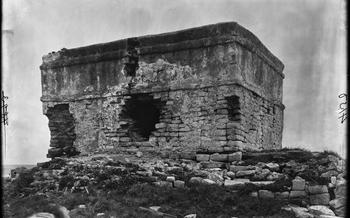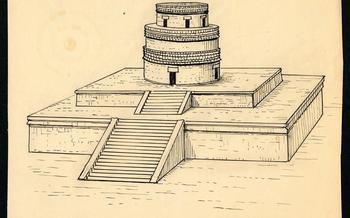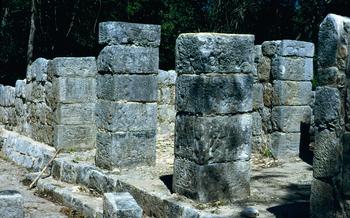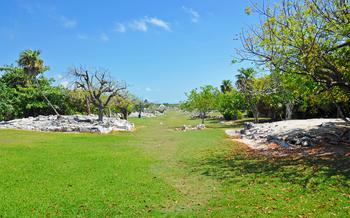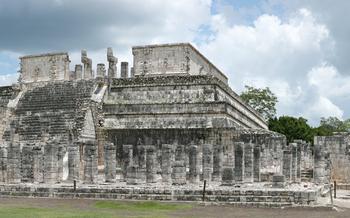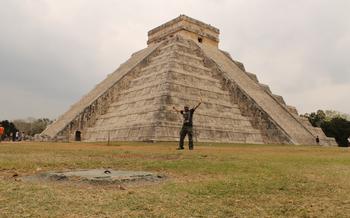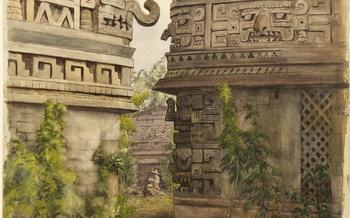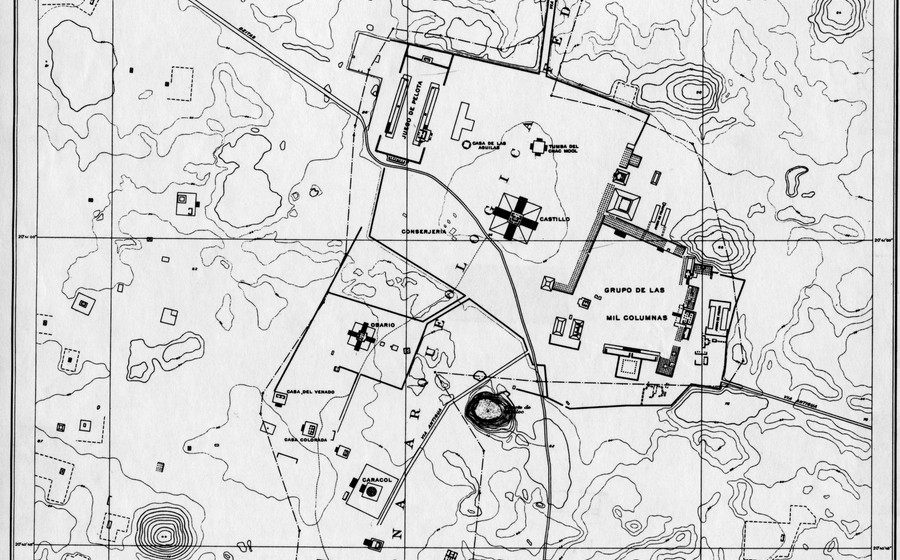
Mayan Museum of Cancun
- Chichen Itza: Unveiling the Mysteries of the Ancient Mayan City
- Exploring the Archaeological Site: A Journey Through Time
- The Pyramid of Kukulcan: A Masterpiece of Mayan Architecture
- Architectural Details
- Astronomical Significance
- Symbolism and Mythology
- Climbing the Pyramid
- The Sacred Cenote: A Portal to the Mayan Underworld
- The Great Ball Court: A Place of Ritual and Competition
- The Temple of the Warriors: A Showcase of Mayan Prowess
- The Temple of the Jaguars: Uncovering the Secrets of the Feline Deities
- The Caracol Observatory: A Window to the Cosmos
- The Cenote Xtoloc: A Place of Natural Beauty and Ritual Significance
- The Museum of Chichen Itza: Unveiling the Treasures of the Past
- The Temple of the Skulls: A Place of Ritual and Sacrifice
- The Cenote Hubiku: A Hidden Gem for Nature Lovers
- Insider Tip: The Best Time to Visit Chichen Itza
Chichen Itza: Unveiling the Mysteries of the Ancient Mayan City
Nestled deep in the heart of the Yucatan Peninsula, Chichen Itza stands as a testament to the ingenuity and cultural achievements of the ancient Maya civilization. This awe-inspiring city, once a vibrant center of commerce, religion, and politics, invites travelers to embark on a journey through time and uncover the secrets of its storied past.
Historical Significance:
Chichen Itza's history dates back to the 6th century AD when the Maya established a small settlement in the area. Over time, the city grew in size and importance, eventually becoming one of the most powerful and influential city-states in the Maya region. Chichen Itza reached its peak during the Late Classic period (800-1000 AD), when it dominated much of the northern Yucatan Peninsula and established trade routes throughout Mesoamerica.
Architectural Marvels:
Chichen Itza is renowned for its architectural marvels, which showcase the Maya's advanced knowledge of engineering, mathematics, and astronomy. The city is home to some of the most iconic structures of the Maya civilization, including the majestic Pyramid of Kukulcan, the Great Ball Court, the Temple of the Warriors, and the Temple of the Jaguars.
Cultural Legacy:
Beyond its impressive architecture, Chichen Itza is a treasure trove of cultural artifacts and traditions that offer a glimpse into the rich cultural legacy of the Maya. From intricate carvings and sculptures to elaborate murals and hieroglyphic inscriptions, the city's ruins provide valuable insights into the Maya's beliefs, customs, and way of life.
Natural Beauty:
Chichen Itza is surrounded by a breathtaking natural landscape that enhances the allure of the ancient city. Lush tropical forests, cenotes with crystal-clear waters, and vast expanses of jungle provide a picturesque backdrop for exploring the ruins. The combination of historical significance, architectural wonders, cultural heritage, and natural beauty makes Chichen Itza a captivating destination that promises an unforgettable journey into the heart of the Maya civilization.
Exploring the Archaeological Site: A Journey Through Time
Chichen Itza is a vast archaeological site, and exploring it can be an overwhelming experience. To make the most of your visit, it's essential to plan your route and prioritize the attractions that interest you the most. Some must-see structures include the iconic Pyramid of Kukulcan, the Temple of the Warriors, the Temple of the Jaguars, and the Great Ball Court. Each of these structures holds a unique significance and offers a glimpse into the ancient Mayan civilization.
If you're short on time, consider joining a guided tour. Knowledgeable guides can provide insights into the history, significance, and symbolism of each structure, making your visit more enriching and informative. For a more intimate experience, opt for a self-guided exploration. Wander through the ruins at your own pace, soak in the atmosphere, and let your imagination transport you back in time.
Don't forget to bring your camera to capture the essence of Chichen Itza. The ancient ruins, lush landscapes, and vibrant colors create a photographer's paradise. Remember to be respectful of the site and avoid using flash photography, as it can damage the fragile structures.
The Pyramid of Kukulcan: A Masterpiece of Mayan Architecture
The Pyramid of Kukulcan, also known as El Castillo, stands as the most iconic structure in Chichen Itza. Its sheer size and architectural precision are a testament to the advanced engineering skills of the ancient Maya. The pyramid's four sides are adorned with intricate carvings depicting feathered serpents, mythical creatures, and historical events.
Architectural Details
The pyramid's design is a marvel of symmetry and precision. It consists of nine levels, each representing one of the Mayan underworld's nine levels. The pyramid's base measures approximately 55 meters on each side, and it rises to a height of 30 meters. The grand staircase on the pyramid's northern side is flanked by balustrades adorned with carved serpent heads, which add to the structure's imposing presence.
Astronomical Significance
The Pyramid of Kukulcan is renowned for its astronomical significance. During the spring and fall equinoxes, the setting sun casts a shadow on the pyramid's northwest corner, creating the illusion of a serpent slithering down the staircase. This phenomenon, known as the "Serpent's Shadow," is a testament to the Mayans' advanced understanding of astronomy and their ability to align their architecture with celestial events.
Symbolism and Mythology
The Pyramid of Kukulcan holds deep religious and cultural significance for the ancient Maya. It was dedicated to Kukulcan, the feathered serpent god, who was revered as the bringer of rain and the patron of agriculture. The pyramid's symbolism extends beyond its physical form, representing the connection between the earthly and spiritual realms.
Climbing the Pyramid
For the adventurous traveler, climbing the Pyramid of Kukulcan is a must-do experience. The steep and narrow steps can be challenging, but the breathtaking views from the top are worth the effort. As you ascend, you'll gain a newfound appreciation for the pyramid's grandeur and the ingenuity of its ancient builders.
The Sacred Cenote: A Portal to the Mayan Underworld
In the heart of Chichen Itza lies the Sacred Cenote, a natural sinkhole that holds deep cultural and historical significance for the ancient Maya. Believed to be a portal to the Mayan underworld, Xibalba, the cenote served as a place of religious rituals, ceremonies, and human sacrifices.
Maya believed that cenotes were sacred portals to the underworld, and the Sacred Cenote was considered the most important of all. It was here that the Maya conducted their most important religious ceremonies, including sacrifices to the rain god Chac.
Archaeological excavations have revealed a wealth of artifacts at the bottom of the cenote, including gold, jade, and ceramic objects, as well as human remains. These offerings were believed to appease the gods and ensure the continued flow of water from the cenote.
Although human sacrifice was a common practice among the Maya, the sheer number of human remains found in the Sacred Cenote suggests that it was a place of particular significance for this ritual. It is believed that the Maya believed that sacrificing their most precious possessions, including their own lives, would ensure the continued favor of the gods.
The Great Ball Court: A Place of Ritual and Competition
In the heart of Chichen Itza lies the Great Ball Court, an awe-inspiring testament to the ancient Maya's prowess in sports and rituals. Measuring an astounding 545 feet in length and 225 feet in width, it is the largest ball court ever discovered in the Maya world.
Beyond its sheer size, the Great Ball Court is captivating for its intricate design and symbolic significance. The walls are adorned with intricate carvings depicting scenes of the Maya ball game, along with representations of deities and mythical creatures. At the center of each end zone stands a massive stone ring, through which the ball had to pass to score a point.
The Maya ball game, known as pok-ta-pok, was not merely a sport but a sacred ritual deeply intertwined with Maya religion and mythology. The game was believed to have cosmic and spiritual implications, with the outcome often seen as a reflection of the balance between the forces of light and darkness.
Visitors to Chichen Itza can immerse themselves in the history and significance of the Great Ball Court by participating in a simulated ball game or witnessing a demonstration. These immersive experiences provide a glimpse into the ancient Maya's sporting prowess and the profound cultural significance of the game.
The Temple of the Warriors: A Showcase of Mayan Prowess
Amidst the grandeur of Chichen Itza, the Temple of the Warriors stands as a testament to the architectural prowess and military might of the ancient Maya. Adorned with intricate carvings and impressive structures, this temple complex played a pivotal role in the city's political and military life.
As you approach the temple, marvel at the intricate carvings that adorn its facade, depicting scenes of warfare, religious ceremonies, and daily life. The temple's sheer size and grandeur are awe-inspiring, showcasing the advanced engineering skills of the Maya.
Explore the temple's interior chambers and discover the secrets they hold. The main chamber features a row of massive columns, each topped with a Chac Mool statue, a reclining figure with a bowl-shaped receptacle on its stomach, believed to have been used for offerings.
Climb the steep steps to the temple's upper levels and be rewarded with panoramic views of the ancient city and the surrounding jungle. The Group of a Thousand Columns, an array of towering columns arranged in rows, surrounds the temple, adding to its grandeur and creating a sense of awe.
The Temple of the Warriors is a must-visit for anyone interested in Mayan history and architecture. Its intricate carvings, historical significance, and stunning views make it one of the most impressive structures in Chichen Itza.
The Temple of the Jaguars: Uncovering the Secrets of the Feline Deities
The Temple of the Jaguars is a captivating structure within the ancient city of Chichen Itza, renowned for its intricate carvings and profound significance in Mayan culture. Dedicated to the revered feline deities, the temple showcases elaborate depictions of jaguars, symbolizing power, strength, and the underworld.
One of the most striking features of the temple is the abundance of jaguar carvings adorning its exterior. These majestic creatures are depicted in various poses, showcasing the Mayans' exceptional artistic skills and their deep connection to the feline world. The jaguars are often depicted with open mouths, revealing sharp fangs, emphasizing their fierce and predatory nature.
Beyond its striking visual appeal, the Temple of the Jaguars holds immense historical and cultural significance. Jaguars were revered by the ancient Maya as guardians of the underworld and intermediaries between the realms of the living and the dead. The temple served as a sacred space for rituals and ceremonies honoring these powerful deities.
In addition to the jaguar carvings, the temple exhibits several other notable architectural features. The entrance is flanked by two large columns topped with Chac Mool statues, depicting reclining figures holding bowls on their stomachs. These statues were believed to represent rain deities, symbolizing the Mayans' dependence on agriculture and their reverence for water.
Excavations at the Temple of the Jaguars have unearthed a wealth of artifacts, including ceramic vessels, jade ornaments, and human remains. These discoveries provide valuable insights into the religious practices and daily life of the ancient Maya.
Overall, the Temple of the Jaguars stands as a testament to the Mayans' profound reverence for the jaguar and their intricate understanding of the spiritual realm. It invites visitors to delve into the fascinating world of Mayan mythology and explore the rich cultural heritage that continues to captivate the world.
The Caracol Observatory: A Window to the Cosmos
The Caracol Observatory stands as a testament to the advanced astronomical knowledge possessed by the ancient Maya. This unique circular tower, with its observation platforms and aligned windows, allowed Mayan astronomers to study celestial events with remarkable accuracy. Explore the observatory's fascinating architectural features, including its circular design and observation platforms, which facilitated precise observations of the stars and planets. Learn how the Mayans used the Caracol to track the movements of celestial bodies, predict eclipses, and mark the solstices. Discover the secrets of Mayan astronomy and marvel at their ability to unlock the mysteries of the universe centuries before modern telescopes. Interactive exhibits bring Mayan astronomy to life, allowing visitors to experience the wonders of the cosmos through the eyes of the ancient Maya.
The Cenote Xtoloc: A Place of Natural Beauty and Ritual Significance
Natural wonders: Nestled amidst the lush vegetation of the Yucatan Peninsula, Cenote Xtoloc beckons travelers with its pristine waters and breathtaking natural beauty. The cenote's crystal-clear waters invite you to take a refreshing dip and explore the vibrant underwater world teeming with colorful fish and fascinating rock formations.
Ritualistic importance: Beyond its natural allure, Cenote Xtoloc holds deep cultural and spiritual significance for the ancient Maya. It was considered a sacred site where they performed religious ceremonies and rituals. Maya believed that cenotes were portals to the underworld, or Xibalba, and held them in high regard.
Swimming opportunity: Take advantage of the opportunity to swim in the cenote's refreshing waters and immerse yourself in its tranquil ambiance. The cool, crystal-clear water provides a sanctuary from the tropical heat, allowing you to relax and rejuvenate surrounded by nature's beauty.
Local legends: Cenote Xtoloc is entwined with captivating local legends and stories that have been passed down through generations. Discover the enchanting tales associated with the cenote, adding a touch of mystery and folklore to your visit.
The Museum of Chichen Itza: Unveiling the Treasures of the Past
The Museum of Chichen Itza, located near the ancient city of Chichen Itza, offers a captivating journey into the rich cultural heritage of the ancient Maya. The museum houses a diverse collection of artifacts and exhibits that shed light on the civilization's artistic prowess, daily life, and religious beliefs.
As you wander through the museum's galleries, you'll encounter an array of pottery, jewelry, sculptures, and other artifacts that showcase the intricate craftsmanship and artistic flair of the Maya. These artifacts provide a glimpse into the everyday lives of the ancient Maya, from their domestic routines to their elaborate religious ceremonies.
Interactive displays bring the Mayan culture to life, allowing you to experience their advanced knowledge of astronomy, mathematics, and writing. Guided tours offer deeper insights into the museum's collection and provide a comprehensive understanding of the Maya's complex civilization.
The Museum of Chichen Itza is a must-visit for anyone seeking to delve deeper into the history and legacy of this ancient civilization. Through its artifacts, exhibits, and interactive displays, the museum offers a window into the captivating world of the Maya, revealing the secrets of their remarkable culture and contributions to human history.
The Temple of the Skulls: A Place of Ritual and Sacrifice
Steeped in a haunting mystique, the Temple of the Skulls stands as a testament to the ancient Maya's complex and often enigmatic belief system. Its walls adorned with intricate carvings of skulls and crossbones, this temple played a central role in Mayan sacrificial rituals and ceremonies.
As you approach the temple, a sense of awe and reverence envelops you. The intricate carvings on the temple's facade depict grinning skulls, each one unique and seemingly imbued with its own story. These carvings are not merely decorative; they represent the severed heads of sacrificial victims, a grim reminder of the dark undercurrents that flowed beneath the surface of Mayan society.
Inside the temple, the atmosphere is heavy with a palpable sense of history. The walls are lined with niches and platforms, where offerings were once placed and rituals performed. The air hangs heavy with the echoes of ancient incantations and the whispered prayers of long-dead priests.
Despite its macabre associations, the Temple of the Skulls is a fascinating and thought-provoking site. It offers a glimpse into the complex and often contradictory nature of Mayan culture, where beauty and brutality were intertwined in a delicate dance of life and death.
The Cenote Hubiku: A Hidden Gem for Nature Lovers
Delve into the enchanting world of Cenote Hubiku, a hidden gem tucked away from the bustling crowds of Chichen Itza. Surrounded by lush vegetation, this breathtaking cenote offers a tranquil oasis for nature enthusiasts and adventure seekers alike. Immerse yourself in the crystal-clear waters, perfect for a refreshing swim or snorkeling expedition to discover the diverse underwater world that lies beneath the surface.
Explore the interconnected caves and tunnels that surround the cenote, leading you on a subterranean adventure filled with awe-inspiring natural formations. As you venture deeper into the intricate cave system, you'll uncover hidden chambers and passageways that reveal the secrets of this underground paradise.
Take this opportunity to connect with the local Mayan community, who are proud to share their traditions and customs with visitors. Engage in meaningful conversations, learn about their way of life, and gain a deeper understanding of the rich cultural heritage that surrounds Chichen Itza.
Cenote Hubiku is more than just a natural wonder; it's a place where you can reconnect with nature, embrace the local culture, and create lasting memories. Don't miss the chance to experience the magic of this hidden gem during your visit to Chichen Itza.
Insider Tip: The Best Time to Visit Chichen Itza
Timing is crucial when planning a trip to Chichen Itza to ensure an optimal experience. The dry season, spanning from November to April, offers the most favorable weather conditions, with minimal rainfall and pleasant temperatures. This period is ideal for exploring the ancient ruins without the discomfort of excessive heat or humidity.
To avoid the peak tourist crowds and capture stunning photographs, consider arriving early in the morning or late in the afternoon. The golden light of sunrise and sunset casts a magical glow on the ancient structures, creating a picturesque backdrop for your travel photos.
Take advantage of the local markets near Chichen Itza to purchase souvenirs and handicrafts that showcase the rich cultural heritage of the region. These markets offer a glimpse into the daily lives of the local Mayan community and provide an opportunity to support their livelihoods.
